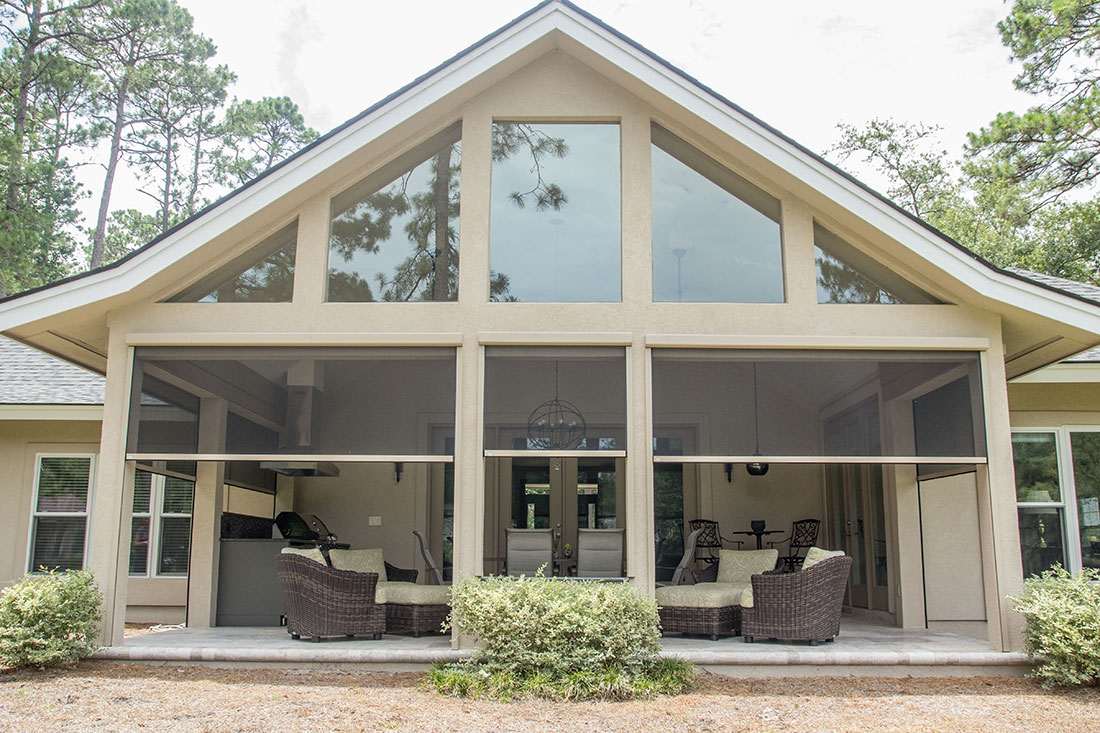Saving Energy (and Money) at Home with Solar Screens
Most folks around here in the vicinity of Savannah and Hilton Head Island are familiar with some type of solar screens. They’re an attractive option for providing shade in our sunny corner of the world. But you might not realize just how great solar screens are at saving energy.
Read on to learn how much you stand to save in home energy costs.

Sunlight Can Make Saving Energy Challenging
Too much heat ...
While the sun feels warm and wonderful when you’re at the beach or playing with the kids in the backyard, the heat from its light is often too intense when it shines through untreated windows.
This effect, called passive solar heating, may be welcome during the winter months. But as summer approaches, the sun’s rays cause increased demand on your central air unit to counter the rise in indoor temperature.
Or too little light?
As spring turns to summer, you can draw the curtains to block out the sun. But that isn’t ideal for a couple of reasons.
For one thing, natural light shouldn’t have to be sacrificed just to keep your home cool. And since heat will still be created between the window and the curtains, this approach isn’t very effective anyway.
So the sun is both welcome and problematic for folks around here. Our sunny skies are a lovely asset … and can be an expensive problem.
How Extra Cooling Cost Adds Up
You might not think the added heat from sunlight is that big of a deal. But if your central air unit is in good working condition, it’s probably kicking in before you know what’s really going on.
The energy transmitted through untreated windows is overheating the interior of your home more than you think. And your central air is working hard to compensate.
1. Air temperature increases.
It’s getting warmer outside as summer approaches. Naturally, you fire up the AC. Meanwhile, the angle of the sun is still low enough that a lot of sunlight is hitting your south-facing windows throughout the day.
2. Your windows convert sunlight to heat.
In direct sunlight, clear windows admit about 1,000 W/m2 (Watts per square meter). According to research, at the sun’s angle in the spring and early summer, your south-facing windows are transmitting as much as 50% of that power (500 W/m2) and converting it to heat.
3. Your AC unit works harder to compensate.
It takes an equal amount of power exerted by your air conditioning system to work against that added heat, and the energy expended in kilowatt-hours (kWh) is what you pay for. So for each single square meter of window, your unit is using an extra 500 Watts per hour, or 0.5 kWh.
4. You use more kWh.
If you get that intensity for about 10 hours per day, 10 hours/day x 30 days = 300. 300 hours x 0.5 kWh = 150 kWh added to your bill per square meter of window.
Now, how much surface area do you have in south-facing windows? A standard window is 2’4” x 2’6”, or a little over half a square meter. Let’s say you have 6 of those on the south side. That’s 3 square meters, or an additional 450 kWh per month on your power bill.
5. It jacks up your electricity bill.
The average cost per kWh in this part of the country (Georgia/South Carolina) is around $0.10 per kWh. At that rate, you could be paying an additional $45 every month in the spring/summer season due to combating solar-generated heat alone.
Of course, it may be much more than that!
- This math doesn’t take into account solar radiation hitting windows on the east and west sides of your home, which also admit heat, just to a lesser extent.
- You may have more window surface area.
- And your kWh rate could be higher.

Saving Energy with Solar Screens
If all this makes you want to cover your house in aluminum foil to send the sun’s pesky rays back where they came from, hold on. There’s a much better way to cut your home energy costs.
Screens may be the perfect solution. They significantly reduce the conversion of solar energy to heat without blocking your view. With screens, you can still enjoy those gorgeous sunny days without worrying about energy waste.
You just need to decide whether you’re going with an interior or exterior screen.
Interior Solar Screens (Manual or Motorized)
Interior screens may either be motorized and controlled by remote, or non-motorized as a lower-cost option and still easily reached to draw them down or retract them. They provide excellent solar screening as they reduce admittance of the sun’s power by around 40%.
Exterior Solar Screens (Motorized Screens)
The exterior version is more often motorized for ease of use. They have the added benefit of being situated between the sun and the window, and are therefore even more effective at blocking solar radiation. Exterior screens can reduce solar admittance by up to 82%.
Start Saving Energy with Solar Screens Today
Here at Coastal Canvas, we say we make more than shade. Solar screens are a great example. It’s one of many ways we reduce the energy demand triggered by the sun’s rays and save you money, all while giving your home a stylish look.
We’ve helped lots of business owners and homeowners like you find the perfect solar screen solution. Now it’s your turn. Call Coastal Canvas and ask for your free energy-saving consultation today!








